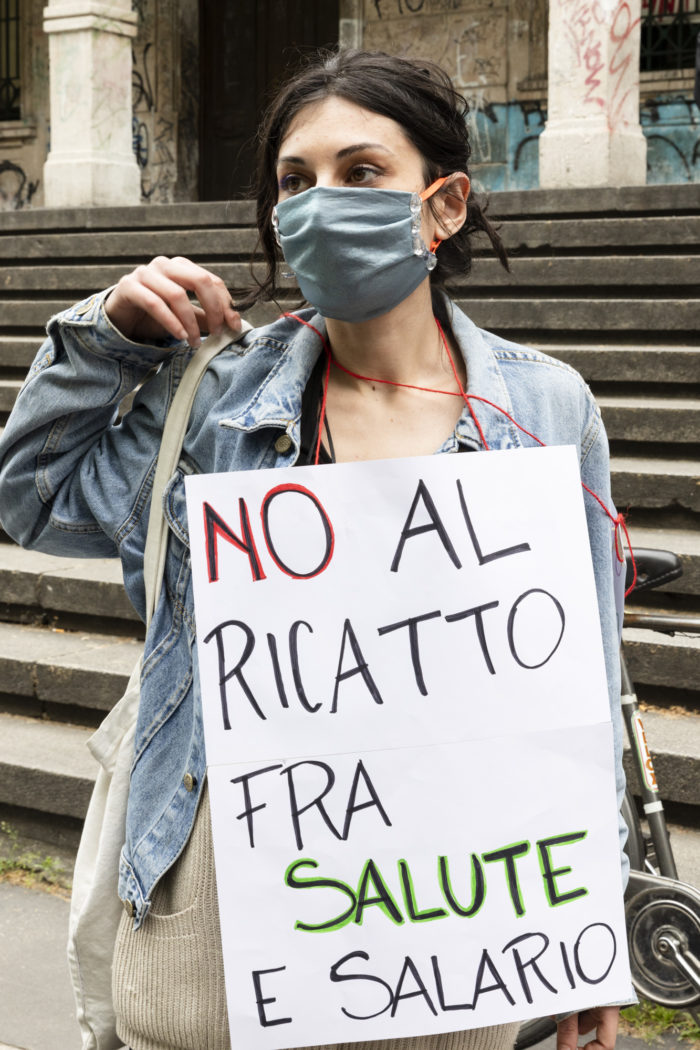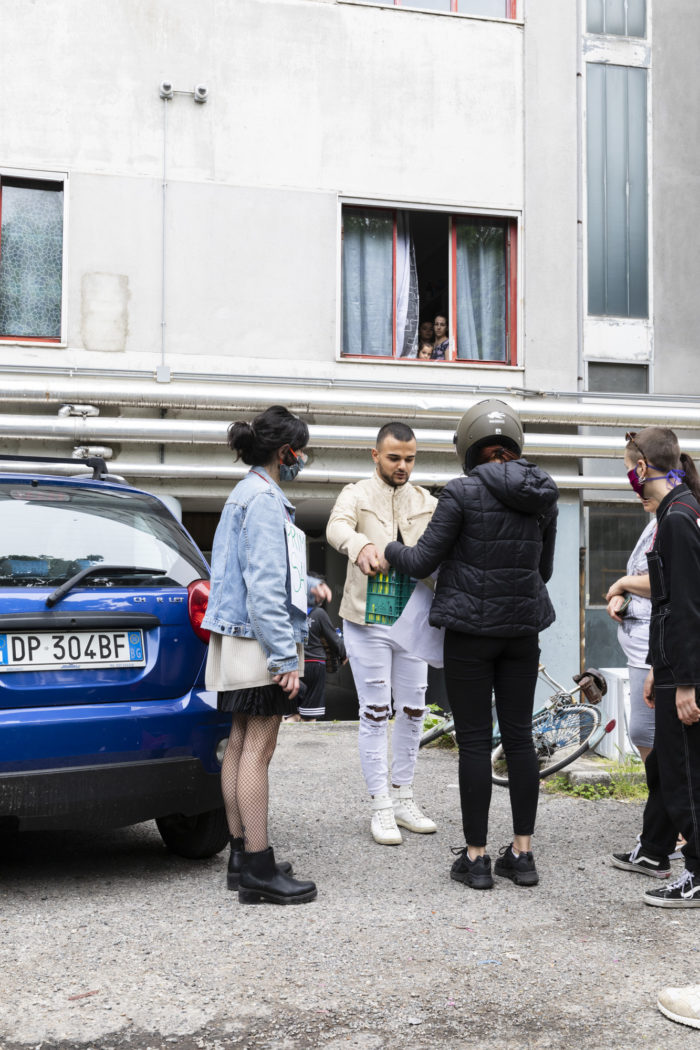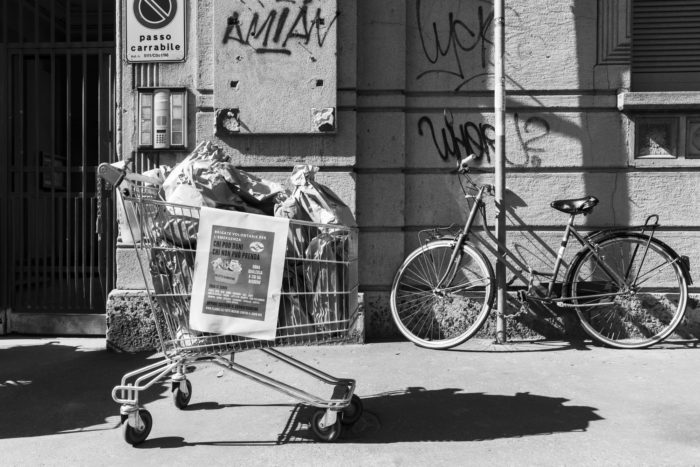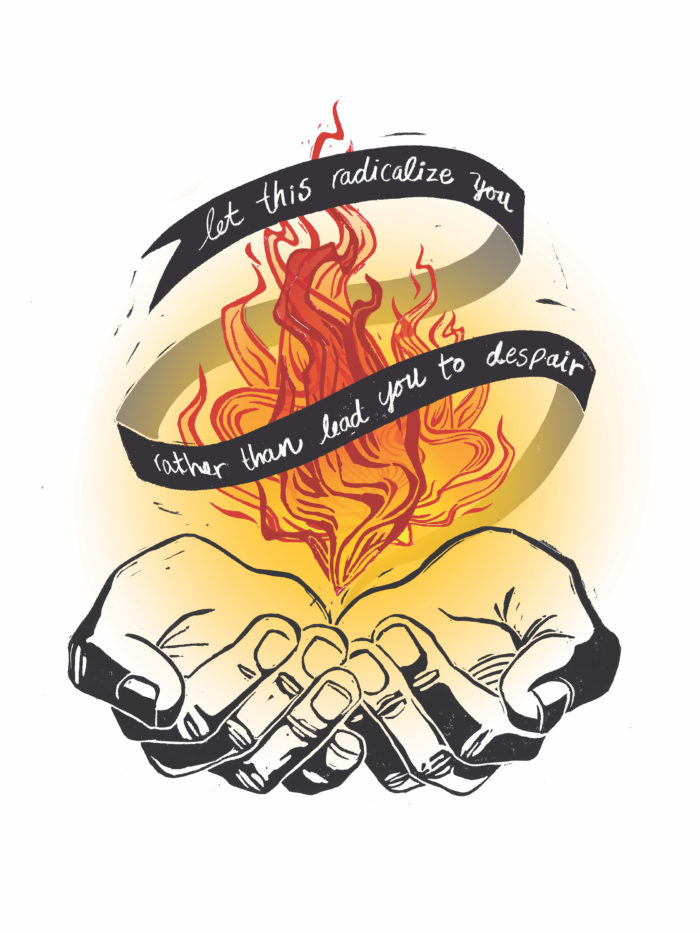As millions of people around the globe went into isolation, we started asking ourselves how we should react to this situation. Many felt the need to go and help, while others blindly followed the guidelines and restrictions imposed by governments. At the same time, the system’s contradictions—even during an enormous public health crisis—emerged ever more clearly. As these types of calamities are happening more frequently, this is becoming our new reality. And it is increasingly clear that there is a need to find an alternative that puts people and nature back at the center of politics.
When a society is confronted with an unexpected catastrophe, be it warlike conflict, a sudden scarcity of resources, or a natural phenomenon, human empathy, mutual aid, and solidarity tend to come to the fore. Despite the ideological dominance of capitalism, humans still possess an almost reflexive tendency to come together and develop spontaneous forms of support and collective organization even during times of deep agony. Humans are fundamentally social animals. Coming together is also a means for us to deal with stress, uncertainty, and insecurity in a changing environment. This trend has happened so often and in such different circumstances that it has been granted its own name: “Disaster Communism.”(1)
For centuries, liberals and other preachers of the state system persuaded people through psychological, social scientific, and philosophical theories to believe that humans need to be under centralist control to prevent falling into a state of perennial war against each other. According to these theories, in the case of disaster, citizens would only think for themselves selfishly looting and preying on others. The whole of “official history” has been written to support these perspectives, most of which have their roots in Thomas Hobbes’s ideas about the “State of Nature.” In Hobbesian speculations, statelessness equals a so-called “state of nature” in which “man is a wolf to man” and “a war of all against all” mentality would prevail. In this way, statehood, centralization, and institutionalized hierarchies are rationalized.
Nevertheless, since the 17th century, political philosophers and social movements have contested Hobbesian theory and the liberal paradigm. In the 19th century, Karl Marx, Mikhail Bakunin, and Peter Kropotkin among other leading socialist theorists of the emergent workers’ movement argued for a more social, empathic, and communal view of humanity. In his book Mutual Aid: Factor of Evolution Kropotkin, for example, countered the Social Darwinism that was prevalent at that time. Kropotkin advanced a view that mutual aid and cooperation determine the natural world, including survival of species and evolution, as much as competition between individuals. These ideas have been developed further in the 20th century and reinforced with the methodology of new social sciences, particularly anthropology and sociology.
Within the discipline of anthropology, researchers such as Pierre Clastres and Viveiros de Castro have written about communities that are not only stateless but have also organized themselves into communal structures that actively prevent the emergence and formation of centralized state. Anthropologist researchers David Graeber and James C. Scott observe that many stateless societies have actually been based on communal values of sharing and reciprocity and haven’t remotely resembled Hobbesian ideas of the “state of nature.” In fact, Graeber and Scott agree that those communities have steadfastly adhered to their communal lifestyle and actively resisted the emergence of state, centralization, and class society.
In his book Debt: The First 5000 Years, Graeber argues that these communal values and practices live in the people’s consciousness and praxis even long after state formation. As he explains, this “everyday communism” forms the basis for all human sociability even in capitalist societies. According to Graeber, the existence of capitalism is dependent on a vast amount of everyday interactions that follow distinctively communistic ethics of sharing and reciprocity instead of the liberal market logic of individual benefit and exchange value. As most of everyday social interactions fall in this category, society should be recognized as independent from state and capital. Similar analyses have been put forward by Murray Bookchin in his book The Ecology of Freedom and Abdullah Öcalan, who attracted global attention with his five volume book Manifesto for a Democratic Civilization.
Applying the research of the above referred theorists to the question of Disaster Communism: Disaster Communism must be viewed as liberation, intensification, and expansion of the communal and communistic practices of society in a situation where unexpected disruption (natural or human-generated catastrophe) loosens the pressure of liberalism, the state, and capitalism.
Having researched human response to earthquakes, wildfires, explosions, terror attacks, and hurricanes in the 20th century, in her book A Paradise Built in Hell Rebecca Solnit also argues that practical evidence supports the communal view on human organizing rather the Hobbesian constructions. According to Solnit, in situations where the state suddenly becomes dysfunctional, or where statist and capitalist governance breaks down, humans show more solidarity and responsibility towards other humans and the environment, not less.
Epidemics, however, are a catastrophe of a unique nature. They force us to reevaluate not only our understanding of ourselves, human relationships and our societies, but also our comprehension of crisis behavior and organization. Epidemics disrupt not only the material but also the social basis of a community. Indeed, epidemics seem to be the most anti-social of all crises, striking directly against our social and communal character while exacerbating inequality within society. Because of the coronavirus, people in several countries cannot even mourn their loved ones together. For months funerals have been forbidden and family and friends of the deceased have had to grieve alone.
Going Beyond the Crises: Pandemic Communalism
The coronavirus has brought huge disruptions to everyday life, social relations, and most importantly, conventional ways of mobilizing political and humanitarian initiatives. It is clear that Covid-19 is just a symptom of a much larger and systemic problem that points to the capitalist system and its domination of nature. Climate change and its effects will be more and more present in our lives if states do not change course and try to reduce carbon emissions effectively.
As we navigate this new pandemic world, it is clear that human behavior resulting in Disaster Communism will not emerge spontaneously on a scale sufficient to face epidemic crises. Yet, a lack of meaningful and communal participation may have enormous humanitarian, psychological, and societal consequences given the need to go beyond the material concerns and to provide answers to our socio-emotional and even spiritual needs in times of agony. Epidemics affect every aspect of society; therefore, also disaster relief and solutions must holistically reflect all of society. Instead of the often spontaneous and local Disaster Communism, we may call this approach “Pandemic Communalism” to highlight its organized, societal, and federal nature.
The term communalism originated in the Paris Commune of 1871, when Parisians took up arms to defend a confederation of cities and towns they had created as an alternative to the republican nation-state. It has gained currency more recently in the writings of Murray Bookchin who describes it as an assembly form of grassroots democracy in which autonomous confederated municipalities collaborate in creating a powerful political and economic network that stands in opposition to the nation-state.
Pandemic Communalism should be the inspiration, which gives concrete political and organizational frame for organizing society facing pandemic disaster. In fact, we should use this moment as an opportunity to transcend the limits imposed by the established system and to bring politics back to the center of community life, thereby regaining its original meaning as the self-administration of a community. The Pandemic Communalism perspective aims to establish new institutions outside the state, built within and around communities wherever there is a void left by governments unable to understand and to meet the real needs of communities in time of a disaster. Moreover, Pandemic Communalism challenges the current system by offering answers that are outside the state framework, empowering communities to advance their own organizational capabilities. In order to pursue this path, there is need for a high degree of commitment, responsibility, and creativity.
In the past few months there have been several movements around the world trying to tackle issues that the pandemic has aggravated. Doctors went to the streets of California to take care of homeless patients. Housing activists called for rent strikes.(2) From Spain to the United States more and more people (up to one third of households just in the US (3)) have not been able or willing to pay their rent. Other solidarity campaigns and actions have started around the globe, with a varying degree of organization as each country and movement has tried to face the crisis in different ways. Pandemic Communalism simply means a federative umbrella under which all such initiatives become an organized social power and reclaim a continuously widening part of social life through popular self-administration.

In Milan, Italy, as soon as the outbreak hit the city, “solidarity brigades” were established. In the course of two months almost 1,000 people joined the brigades to support others and almost fourteen brigades started operating in the city. These brigades helped elderly people who were advised not to leave the house with their grocery shopping and medicines and supplied people who lost their jobs with food. And another brigade was established to provide psychological support to anyone struggling emotionally during this time of isolation and hardships.

Brigade Gerda Taro)
As the brigades started working, it was clear there was a need to approach the crisis in a very different way from the past. Valerio, one of the representatives of the Milanese Solidarity Brigades, explained that “everything needed to be re-evaluated” and a certain amount of discipline established in relation to hygienic measures, performance of tasks and other routines.(4) Milan set an example and soon The brigades spread well beyond Italy.(5) Similar groups formed in France, Spain, the United States, and Brussels. At the moment there are fifty-four brigades around the world. “We are talking to one another and sharing experiences and perspectives,” said Clara who is working in the coordination group for the Milanese brigades. As the pandemic appears to come under greater control, most of the countries are lifting some of the very restrictive measures, and most of the brigades are asking themselves what will be next and how they should approach the so-called “Phase 2.”
Unlike conventional forms of organization that have emerged in past crises, Pandemic Communalism is not born from semi-spontaneous networks that develop in mass meetings, protests and gatherings. In this crisis, the starting point is extreme physical isolation. During epidemics, it is organization, trust, and discipline that allows larger and larger gatherings, not the other way around. The first mission in constructing Pandemic Communalism is, therefore, to develop a form of organization of mutual aid that can break the isolation and bring people together.

Brigade Gerda Taro)
Fundamental for Pandemic Communalism is a mentality that each and every human can have a positive influence on the well-being of people in their environment. So far, the state mentality has pushed a single narrative: everyone is a potential virus carrier, so it is better to stay home, isolated, and if anyone dares to step out of their homes, he or she is singled out and accused of not caring for their own community. Meanwhile, thousands of non-essential factories and industries have continued working, and effectively continued as the hubs of contagion. Most of the times workers were not provided with the right protective equipment. In so doing, the state intent is to blame citizens if the virus doesn’t halt the spread while failing to recognize its own responsibilities in the crises.
This view that salaried work as the only legitimate way to participate in society is severely limited. There are multiple other ways to be active and to contribute to the good of society by voluntary and self-organized means. Even rudimentary collective structures can protect people belonging to risk groups. Groceries have often been cited as a simple and concrete example: if neighbors divide shopping in shifts, they can have foodstuffs with minimal close contacts. Such division and rotation of tasks and responsibilities can be established for most everyday needs. Thus, human contacts and the epidemic growth speed can be decreased while simultaneously building community organization.

Brigade Gerda Taro)
The main characteristic of Pandemic Communalism is to expand primarily in the field of reproductive labor—all forms of labor that reproduce the work force, and the material and social basis of production. Child bearing, education, health care, cleaning, cooking and other housework as well as different forms of care work are often cited as examples of reproductive labor. Studying can also be seen as reproductive work when people prepare and educate themselves for what the system calls “real” or productive work. In capitalist societies reproductive labor is performed mainly by women, whether it be in non-salaried work at home or wage labor. Therefore, it has become a field of analysis, critique, and resistance for revolutionary feminists such as Silvia Federici and Selma James.
Housing, education, upbringing, child care, and care work in general as well as feeding are precisely the basic questions to which the Pandemic Communalism perspective attempts to provide new solutions that are not based on the state or patriarchal family. Pandemic Communalism is, therefore, oriented towards feminism and women’s liberation. Communal structures have the possibility – and even the duty – to overcome traditional gender roles and the resulting barriers and division of work. The problems of households are also not limited to the questions of economy and sustainability, but to problems such as alcoholism and substance abuse, domestic violence, and mental health issues that are central in times of quarantine. Solutions for these issues must be formulated and provided.
First Steps Towards Pandemic Communalism
There is no need to be an organized group to start working toward Pandemic Communalism. Depending on the neighborhood, an apartment building, or even a tiny group of smaller houses, could be the context in which to start organizing relevant responsibilities, roles, and tasks. A community of some dozens of people should be enough to take care of most basic everyday needs. These needs could include, for example: helping people running errands (groceries, post office, library, pharmacy); sharing responsibility for children in case schools and institutions are shut down; making the internet, cars, common spaces, and other basic resources available for common use; even purchasing and distributing prime necessities collectively should they become scarce in the future.

Brigade Gerda Taro)
When apartment complexes, or whole neighborhoods become organized, the primary question is then how can they coordinate with other similar units. Committees or working groups for autonomous health care, food supply, domestic problems, and other logistics can be established to confront issues that are common for all. Each region, city, and neighborhood will organize itself as defined by its own characteristics, depending on the level of social organization prior to the epidemic and other factors. In some cities there are plenty of existing mutual aid groups, neighborhood organizations, and other groups whose role is boosted in these times. Other cities and neighborhoods have started to organize themselves virtually from scratch, from the informal connections and ties between the inhabitants. However, every locality faces the same questions: how to take over more responsibilities and expand the functioning of these self-administered structures and networks? How to unify all the different initiatives into an organized and coordinated entity? How to build social power beyond reciprocal mutual aid with limited resources? These are the main questions that arise when initiatives start to federate their activities and structures, bringing to life the societal and confederal perspective of Pandemic Communalism. At this point, Pandemic Communalism transcends the limits of single relief efforts and starts to take shape as an alternative communal fabric of everyday life and to reveal its systemic character.
In the time of an epidemic, social self-organization should be based on the principles of decentralization and compartmentalization. Compartmentalization means dividing a crowd of people into small “compartments” and minimizing close contact between the different compartments. Such organization is developed to prevent the spread of sickness to other units and to protect the whole, if one of them is contaminated. The state’s curfew policy is using the same logic, trying to control movements – and thus contagion – between different districts, cities, and even neighborhoods.
However, if state-imposed compartmentalization and isolation is fully implemented it will destroy the decision-making structures, production, and societal logistic and thus, at the end of the day, the whole society. The compartmentalization of a city, for example, is practically limited by the fact that people tend to not work in the area where they live (not even in the same city sometimes), that local groceries cannot feed the people of the neighborhood, and on the neighborhood-level there are no decision-making structures that would guarantee the continuation of social life.

Brigade Gerda Taro)
Rigid centralized governments and companies that follow the irrational logic of markets with their grocery stores and miles long supply chains are thus becoming obstacles to the counter-epidemic policies. The ability to adapt to new circumstances and resilience can be increased with a combination of decentralization and coordination, i.e. with more local democracy and federalism. This is the true meaning of Pandemic Communalism. Local democratic structures increase people’s capability to make decisions about their lives and react to emerging material problems rapidly and therefore empower the society – regardless of whether any epidemic and mass quarantine are in place or not.
The Political Perspective
A natural foundation of social crisis organizing is mitigation of the humanitarian consequences of a crisis with self-organization and mobilization of local communities and their resources. It differs from the state approach in that social organizing doesn’t only seek to heal the symptoms, but also to empower local communities and, as a result, the whole society. With the creation of locally-rooted and self-governed structures of decision-making, security, care, and logistics, a society shall be not only “restored” but transformed. From the perspective of Pandemic Communalism it is not enough to seek to return to the pre-crisis state, but to construct solutions that will not result in yet another crisis, whether economic or environmental in nature.
At the same time, the economic repercussions of the coronavirus pandemic and its counter-measures are just beginning to be understood. It is clear already that we are entering a new economic crisis; only its magnitude is uncertain. Many analysts are talking about a global recession that might reshape the economic sector for a long time. In the first weeks of the corona outbreak, financial markets around the world sank, while investors and banks were hoping for a quick fix which worked. Production stopped, and so did consumption. We have seen a severe rise in unemployment, and the economic crisis is far deeper than the stock markets indicate. Economists are warning that there is a historically wide gap between the indicators of the real economy and the expectations of stock markets.(6) It is a superficial result of the cheap money that central banks pumped into markets very rapidly in the beginning of the pandemic. However, we should not delude ourselves that the system will collapse by itself with no viable alternative. After all, capitalism is the most dynamic system of all times and therefore it will try to adapt to this crisis and move on. Corona has already shown us how certain corporations, such as Amazon, took advantage and made large profits while forcing their workers to operate without adequate protective gear.(7)
While unemployment, inequality, and difficulties to pay rent and other bills increase, and institutional social security becomes overwhelmed, material problems will reach a level that require organized and broad forms of collective action. Material support can be organized up to a point with the more or less informal networks of friends, relatives, and neighbors. Housing, electricity, water, and other fundamental needs, on the other hand, cannot be guaranteed with the deeds of individuals or small networks and require wider social organizing. At that point, the question is not only of social organization, but also of explicitly political organization; that is, organizing ourselves and our communities for political struggle. Sooner or later questions will emerge: who will be saved? Who will pay the bill at the end of the day? Will finance companies, industry, and banks be saved as happened after the 2008 financial crisis at the expense of lives, homes, and the savings of common people? Or the other way around? The answers to these questions depend only on our capabilities to organize ourselves to defend our lives in all sectors of society.
The political perspective of Pandemic Communalism is to organize the emerging practical solidarity into a political force that can defend the interests and wellbeing of society against both the pandemic crisis and political threats emanating from it. Bank and corporate owners are already in attack-mode, ready to blackmail for more money for themselves, while demanding “flexibility” and “sacrifice” from workers to secure their wealth. Sooner or later, their demands will intensify to include lower salaries, longer working hours, degenerate working conditions, and an obligation to work despite risking one’s health and life.
When the epidemic starts to wither away defending workers, the unemployed, and tenants against these attacks requires solidarity to take a form of coordinated action, such as strikes, protests, and blockades. Mutual aid can be developed in self-organized “counter logistics” that serve social needs regardless of the pressure from companies and their interest organizations.(8) The groups and neighbors that came together via instant messaging and other apps can be the first step to organizing local structures of self-governance that are able to administer the life of the area’s inhabitants and coordinate communally organized services.

Conclusions
It is important to point out that a Pandemic Communalism perspective is not only about the mitigation of crisis’ symptoms. Instead, it is seeking a holistic solution based on the empowerment and defense of society by organizing and federating social initiatives, continuously expanding the sphere of democratic self-governance. To this end, the predominantly social nature of the pandemic must be analyzed correctly.
What is today called the coronavirus crisis is a multi-faceted phenomenon and much deeper than the pandemic itself, which basically encompasses the whole of social life. The virus is from a biological source, but the development of COVID-19 from a local infection to a global crisis has mostly been due to social interactions and dynamics. The main dimensions of the corona crisis have been health care and social reproduction in general, economy, governance, and the relationship between nature and human (society). Above all, these four fields determine the ongoing pandemic dynamics but also witness a deep and severe crisis. More precisely, the coronavirus revealed built-in malfunctions and flaws in the capitalist organization of these sectors of society and brought them to a premature dead end.
Unlike regional disasters such as earthquakes or hurricanes, a pandemic is not local, but affects whole societies. In the case of a pandemic, there is no wider functioning society that can give relief to a single community or locality hit by a disaster. A pandemic is too big and severe of a crisis for local and regional efforts or isolated relief initiatives of the people to handle. Meanwhile, it has also become clear that the ongoing crisis and the economic and ecological disasters looming just ahead of us cannot be solved by a superficial crisis management in the existing framework of states and markets. A sustainable solution must see the crisis as a whole and set in motion a profound transformation of society, and in the four central dimensions mentioned above. Lack of transformative development will inevitably lead to partial and inconclusive attempts that will not grasp the severity of the situation. Furthermore, any partiality or inconclusiveness in these critical times will only lead to continuation and repetition of economic, ecological, and health related crises while states of exception, lock downs, technological surveillance tools, and other ad hoc measures will become a new normality.
Pandemic Communalism is a proposition for such a conclusive solution. It is a perspective that is not limited either to the confines of states and markets or to the relative weakness of isolated relief and charity efforts. Pandemic Communalism can be thought of as a third way, not surrendering to either side of this false dualism. It obviously emerges from local initiatives and builds itself around them, but if developed correctly, it will expand and take over more complicated social responsibilities and increase the sphere of popular self-administration in a democratic and federative way. Meanwhile, its relationship to the state system is a more antagonistic than a symbiotic one, although the two can also find temporary mutually beneficial relationships.
The communal character of Pandemic Communalism begins to be realized when different initiatives of mutual aid and community organizing link up with each other and relate to other initiatives of popular self-organization in a coordinated way. Federating different initiatives in a mutually beneficial, strengthening, and meaningful way is the real art of Pandemic Communalism and source of its power. Such an approach can be understood in the words of Murray Bookchin in his description of the “Meaning of Confederalism:”
Confederalism, in effect, must be conceived as a whole: a consciously formed body of interdependencies that unites participatory democracy in municipalities with a scrupulously supervised system of coordination. It involves the dialectical development of independence and dependence into a more richly articulated form of interdependence […] A choice between either self-sufficiency on the one hand or a market system of exchange on the other is a simplistic and unnecessary dichotomy. (9)
Pandemic Communalism can be thought of as the application of confederalist principles to our current situation of popular crisis organization. The centers or hubs of federalist coordination offer it a distinctive identity that can integrate a growing amount of people, community initiatives, civil society organizations, and other popular actors under a common roof. The resulting constellation is more than the sum of its parts and, therefore, the social power of federated initiatives does not increase linearly, but exponentially. The emerging communal and federal structure – and it alone – can lead Pandemic Communalism to become a real alternative that can reach a level of social organization required to overcome the ongoing crises.
Pandemic Communalism, as a federative and ever-expanding system of interdependencies, offers a framework in which different initiatives can connect with each other and coordinate their activities through popular self-management. When different initiatives federate themselves directly, without the mediation of state and market forces, the corrupting influence of capitalism weakens. It cannot approach each initiative individually and integrate them to the restoration of the old order. Instead, capitalism has to deal with a federated entity that has already started to establish principles, practices, mentalities, and even culture of their own. Thus, the question is no longer one of aiding the system, but rather constructing an alternative system while supporting people and communities. The development of an alternative is the true measure of Pandemic Communalism’s development.
At the end of the day, going back to “normalcy,” and how capitalism has transformed every aspect of our life, would be the worst outcome of the corona crisis. Therefore, instead of figuring out how to return to a “normal” capitalist order, now is the perfect moment to start constructing an order of own— one of wellbeing, freedom, and social ecology. People and nature can both be the winners of this crisis so long as we are able to reclaim our ability to self-govern our communal matters and relate to our environment in an ecological way.
Jean Desta is a pseudonym for a collective of European comrades working and focusing on different areas and social struggles. They are writers, academics and researchers who are deeply influenced by Murray Bookchin, Abdullah Öcalan and other authors in the quest for a revolutionary, libertarian socialist and internationalist perspectives for the 21st century.
(see more of Amanda Priebe’s art at: https://www.amandapriebe.com)
Notes
(1) Out of the Woods, “The Uses of Disaster,” Commune Magazine, October 22, 2018 https://communemag.com/the-uses-of-disaster/
(2) “Rent Strike? A Strategic Appraisal of Rent Strikes throughout History—and Today,” transl. Crimethinc., March 30, 2020 https://crimethinc.com/2020/03/30/rent-strike-a-strategic-appraisal-of-rent-strikes-throughout-history-and-today
(3) Alicia Adamczyk, “32% of U.S. households missed their July housing payments”, CNBC, May 5, 2020. https://www.cnbc.com/2020/07/08/32-percent-of-us-households-missed-their-july-housing-payments.html
(4) Commune, “It’s Time to Build the Brigades,” Commune Magazine, March 27, 2020. https://communemag.com/its-time-to-build-the-brigades/
(5) Solidarity Brigades website: https://www.brigades.info/
(6) Economist, “The market v. the real economy,” The Economist, May 7, 2020 https://www.economist.com/leaders/2020/05/07/the-market-v-the-real-economy
(7) “Coronavirus: Amazon workers strike over virus protection”, BBC, March 31, 2020. https://www.bbc.com/news/business-52096273
(8) Anonymous, Short Circuit – a Counterlogistics Reader (No New Perspectives, 2015).
(9) Murray Bookchin, “The Meaning of Confederalism,” Green Perspectives 20 (1990).

